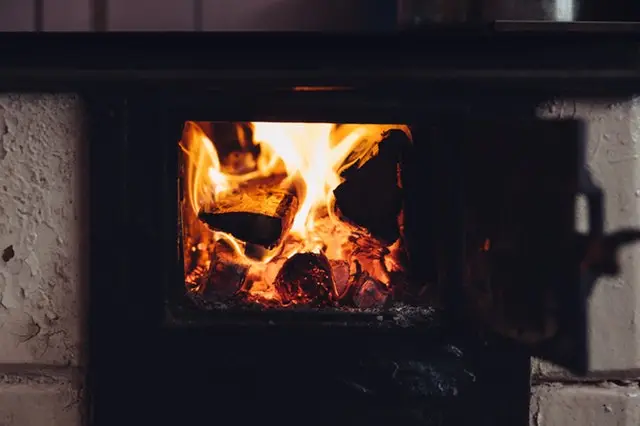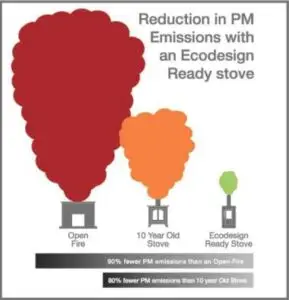
BUYING A NEW WOOD-BURNING STOVE
Replace an open fire or a 10-year-old stove with an Ecodesign stove. Ecodesign stoves have significantly lower emissions and higher efficiency. In an Ecodesign stove air is introduced into the stove, helping to burn off more of the smoke and gases – making these types of stove more efficient.
Consider what stove will be most efficient and less polluting before you install it. The stove you use will make a lot of difference to the amount of air pollution that comes from your house. For instance, open fires are not very energy efficient, they can cause cold draughts in your home and they have high emissions. Older stoves are less efficient, so you need to burn more to get the same heat output. Modern stoves are considerably more efficient and less polluting. Stoves that meet the Ecodesign standard produce the least emissions by burning fuel more efficiently and completely.


Buy a stove that matches the heating requirements of your room. Measure your room and use a wattage calculator to calculate the size of stove you need. If the stove is too big for your room you will waste money and energy. Which has produced a tool to help: https://www.which.co.uk/reviews/wood-burning-stoves/article/wood-burning-stoves-what-you-need-to-know/multi-fuel-and-log-burner-installation
Regularly maintain and service your stove and operate it correctly. Get your chimney swept regularly (at least twice per year). This will increase your stove efficiency, reduce emissions and the risk of a chimney fire. Maintain your stove and get it serviced once a year. Pellet stoves also need to be serviced annually.
OPERATING YOUR STOVE
There are also some things to consider when operating your stove:
- Ensure that you burn fuel at the correct temperature. Running the stove at a lower temperature can cause incomplete combustion – the burning process will be less efficient and create more tar and smoke.
- Remember about proper ventilation in the room to help the fuel burn well.
- You must have a carbon monoxide detector in the room where the stove is installed
See our fuels pages for tips on improving your fire-lighting technique.
Guidance on open fires and stoves can be accessed through the links below:
- Open Fires and Wood Burning Stoves
- How to get the most from your stove or open fire
- Stove wattage calculator
- Which guides on stove installation, operation and maintenance
- The Hetas Guide to Approved Solid Fuel, Wood and Biomass Products & Services
- Wood burning stove installation video
Here are some useful videos on stove installation, operation and maintenance:
Other approaches and technologies available to decrease the carbon foot-print of your home. Ensure that your home is properly insulated – this will reduce your household air pollution emissions, reduce your heating bills and may make your home feel more comfortable. Other technologies include upgrading your old gas boiler to a new efficient type or heat pumps that extract heat from the outside to warm your home.
NAVIGATE CLEAN BURNING PAGES
Next page: EFFICIENT FUEL
Previous page FACTS AND HEALTH
